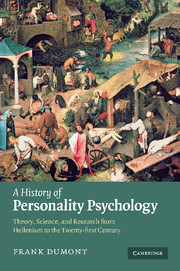 A History of Personality Psychology
A History of Personality Psychology Book contents
- Frontmatter
- Contents
- List of tables and figures
- Preface
- 1 Historical precursors of personality theory
- 2 From illness to wellness models of human nature
- 3 Developmental perspectives on personality: from youth-based to life-span models
- 4 The biology of personality
- 5 Trait theories and the psychology of individual differences
- 6 The puzzle of the self
- 7 Culture and personality
- 8 Gendered personality
- 9 Emotions and reasoning: a definition of the Human
- 10 Taking the measure of the Human: benefits and inherent limitations of personality measures
- 11 Can personality change? The possibilities of psychotherapeutics
- 12 The disordered personality: evolution of nosological systems
- 13 Eight appendices: at the margins of personality psychology
- References
- Author index
- Subject index
3 - Developmental perspectives on personality: from youth-based to life-span models
Published online by Cambridge University Press: 03 May 2010
- Frontmatter
- Contents
- List of tables and figures
- Preface
- 1 Historical precursors of personality theory
- 2 From illness to wellness models of human nature
- 3 Developmental perspectives on personality: from youth-based to life-span models
- 4 The biology of personality
- 5 Trait theories and the psychology of individual differences
- 6 The puzzle of the self
- 7 Culture and personality
- 8 Gendered personality
- 9 Emotions and reasoning: a definition of the Human
- 10 Taking the measure of the Human: benefits and inherent limitations of personality measures
- 11 Can personality change? The possibilities of psychotherapeutics
- 12 The disordered personality: evolution of nosological systems
- 13 Eight appendices: at the margins of personality psychology
- References
- Author index
- Subject index
Summary
Creatures of a day, what is any one? What is he not?
Man is but a dream of a shadow.
But when there comes as a gift of heaven a gleam of sunshine,
There rests upon men a radiant light and, aye, a gentle life.
From an ode of Pindar (sixth century bce), celebrating the victory of an athlete at the Pythian gamesDevelopmental psychology and personality theory
To understand any theory of personality we need to understand the developmental psychology in which it is grounded. Further, we need to appreciate the enormous advances that the science of human development has made over the past century. The theories of personality that were predicated on obsolescent developmental models have become outdated themselves. Stating the obvious, personality theories that reflect the most recent research in developmental psychology inspire the most confidence, everything else being equal. This chapter explores the relationship between the postulates and science of these two disciplines and what they contribute to each other.
Current science informs us that human development is a life-long process, a conclusion we can draw from the recent research of a host of developmental psychologists (for example, Baltes, Reuter-Lorenz, and Rösler, 2006a; see also the balanced and well-documented article by Paul B. Baltes, 1997). Freud (1856–1939), on the other hand, affirmed that personality was largely “set in plaster” by the time the Oedipal conflict of the pre-schooler was resolved (or not resolved as the case might be).
- Type
- Chapter
- Information
- A History of Personality PsychologyTheory, Science, and Research from Hellenism to the Twenty-First Century, pp. 75 - 114Publisher: Cambridge University PressPrint publication year: 2010


